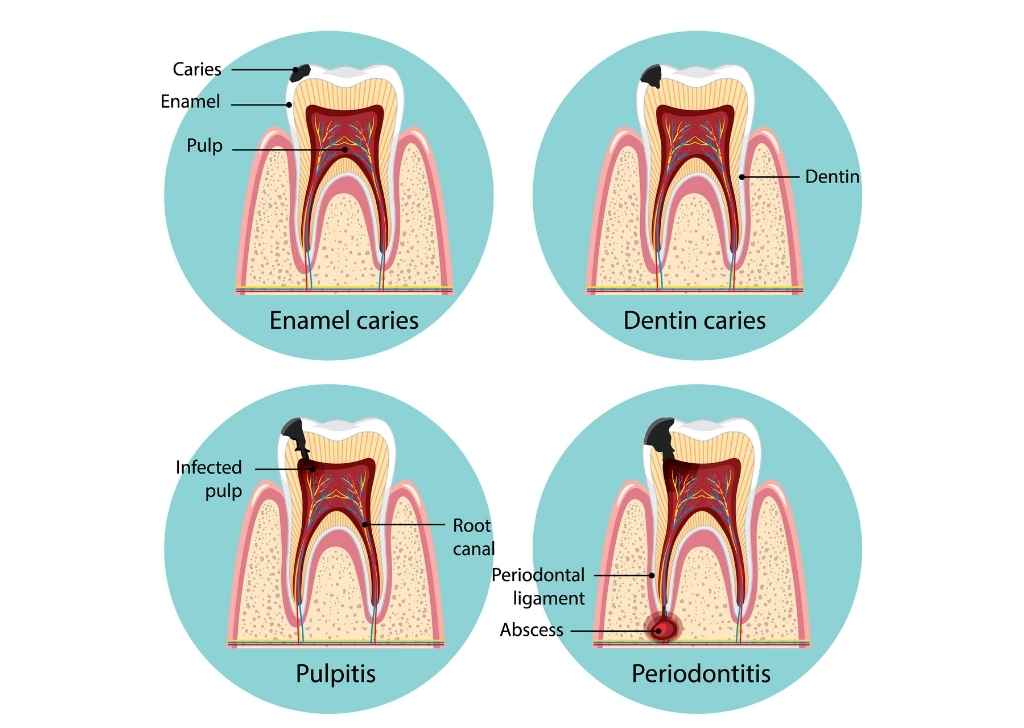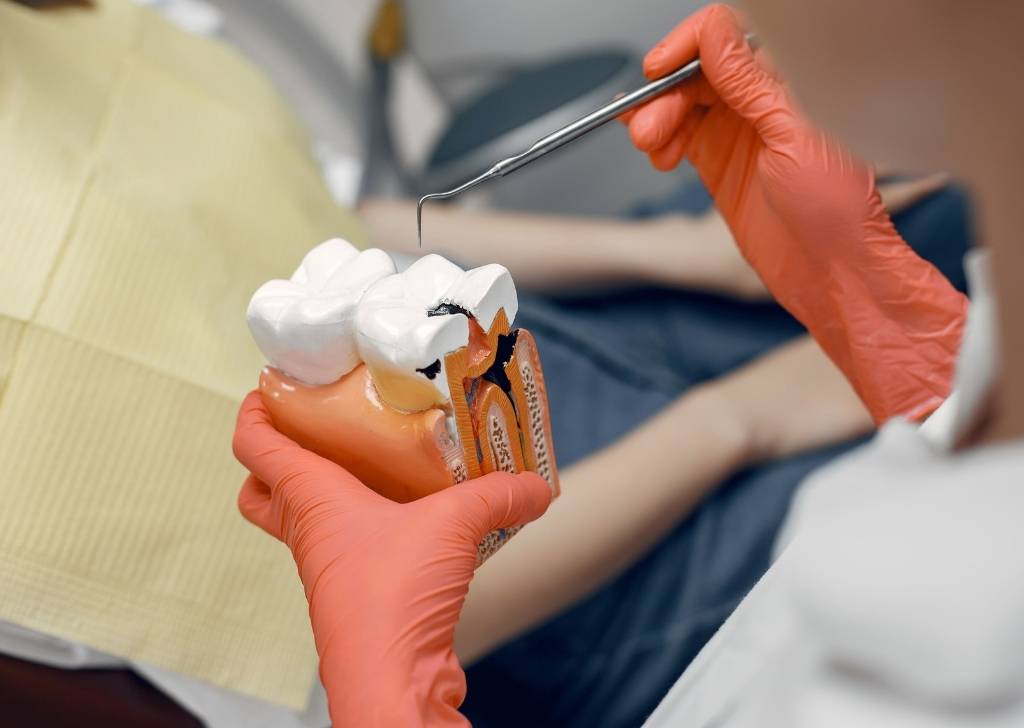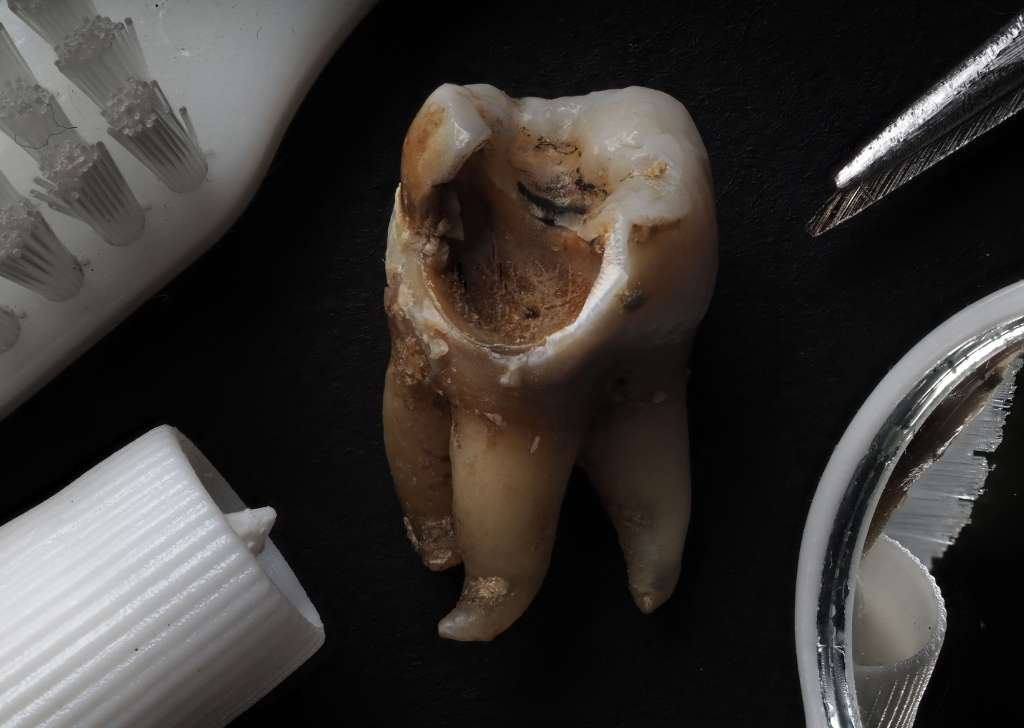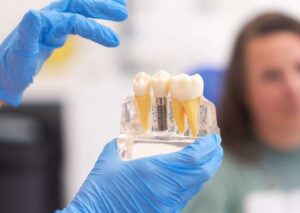Tooth decay happens when harmful bacteria in your mouth break down sugars and starches into acids, which erode your enamel and form cavities. If left untreated, this can lead to pain, infection, and even tooth loss, making early detection and treatment vital.
If you’re already experiencing discomfort or suspect a cavity, it’s important to seek a qualified dentist who can assess whether the decay can be treated with a simple filling or if extraction is necessary. In some severe cases, such as deep decay in molars, a replacement may be needed — dental implants offer a natural-looking, permanent solution.
What Causes Tooth Decay?
Tooth decay is caused by the demineralisation of enamel due to acid attacks from bacteria living in plaque. But there’s more to it than just skipping brushing.
Plaque and Acid Production
Bacteria in your mouth feed on sugars from food and drinks, producing acids in the process. These acids cling to your teeth as plaque, wearing down enamel and creating cavities over time.
Poor Oral Hygiene Habits
Infrequent brushing or flossing allows plaque to harden into tartar, which accelerates decay. Not cleaning properly along the gumline or between teeth also increases your risk.
Sugary and Acidic Diet
Frequent snacking or sipping sugary beverages fuels bacterial growth. Even seemingly healthy choices like fruit juice can erode enamel if consumed too often without rinsing or brushing.
Dry Mouth and Medical Factors
Saliva helps neutralise acids and wash away food particles. Conditions like dry mouth (xerostomia), diabetes, or even certain medications reduce saliva flow, making your teeth more vulnerable to decay.
Genetic Predisposition
Some people naturally have thinner enamel or deeper grooves in their teeth, making them more prone to developing decay even with good oral care habits.
Symptoms of Tooth Decay

Tooth decay doesn’t always start with pain. Sometimes, the signs are subtle and by the time discomfort kicks in, the cavity may already be advanced. Recognising the early symptoms can help you seek treatment before the problem worsens. Noticing any of these symptoms below should be your cue to book a dental appointment. Tooth decay rarely gets better on its own. The longer you wait, the more damage it can do – both to your teeth and your wallet.
Sensitivity to Hot, Cold, or Sweet Foods
If sipping iced water or biting into something sweet makes your teeth sting, it could be an early sign of enamel erosion or a developing cavity. This happens when decay exposes the dentin layer of the tooth, which contains nerve endings.
Visible Holes or Dark Spots
You might notice a small pit or stain on your tooth that wasn’t there before. These are often the first visual signs of decay. In front tooth decay, this can be particularly noticeable and should be addressed quickly to avoid cosmetic and structural issues.
Toothache or Persistent Pain
Dull, throbbing, or sharp pain in a specific area of your mouth – especially when chewing – often means the decay has reached the inner pulp of your tooth. At this stage, simple fillings may no longer be enough, and root canal treatment might be required.
Bad Breath and Foul Taste
Tooth decay creates a breeding ground for bacteria, which can result in persistent bad breath or a sour taste in your mouth, even with regular brushing.
Swelling or Gum Inflammation
Decay close to the gumline, such as in wisdom tooth decay, can irritate or infect surrounding tissue. This can cause swelling or pain in the gums and jaw.
Stages of Tooth Decay
Tooth decay doesn’t happen overnight. It develops gradually, moving through distinct stages – and each stage requires a different approach to treatment. The sooner it’s caught, the easier (and less expensive) it is to manage.

Enamel Caries
Tooth decay begins with the loss of minerals in the enamel, often showing up as faint white spots. As acids continue to erode the surface, small cavities can form, leading to sensitivity. At this stage, decay is still manageable—fluoride treatments, improved oral hygiene, or a simple filling from your dentist can restore the tooth’s health.
Dentin Caries
When decay breaks through the enamel into the dentin — the softer layer underneath — it spreads more quickly. The tooth becomes increasingly sensitive to hot, cold, or sweet foods. Without timely treatment, cavities can enlarge and compromise the tooth’s structure, making professional dental care essential.
Pulpitis
If bacteria penetrate deep enough to reach the pulp, where nerves and blood vessels reside, the pain intensifies. This infection often causes swelling and severe discomfort. Root canal therapy is typically required at this stage to save the tooth and stop the infection from worsening.
Periodontitis
Left untreated, the infection can spread beyond the pulp and form an abscess near the root. This pus-filled pocket can cause extreme pain and swelling, and in severe cases, the infection may reach the jawbone or bloodstream. Advanced intervention, sometimes including tooth extraction may be needed to protect your overall health.
How to Stop the Pain of Tooth Decay With Home Remedies

Tooth decay pain ranges from dull aches to sharp, shooting pain when eating or drinking. Whether it’s a mild discomfort or unbearable, the sooner you address it, the better the outcome.
Immediate Relief at Home
If you can’t get to a dentist right away, there are a few ways to manage the pain temporarily:
- Saltwater rinses help reduce inflammation and clean the affected area. Mix half a teaspoon of salt in warm water and swish it around for 30 seconds.
- Over-the-counter pain relievers like paracetamol or ibuprofen can help ease the discomfort.
- Cold compresses applied to the outside of your cheek may reduce swelling and numb the pain.
- Clove oil, a natural remedy with numbing properties, can be dabbed directly onto the tooth with a cotton swab. It’s not a cure, but it can help in a pinch.
Despite these measures, tooth decay pain will persist until the underlying cause is treated professionally.
Dentist Solutions for Lasting Relief
When you visit a dentist, you’ll be examined for the extent of the decay. Based on the diagnosis, your dentist might recommend:
- A filling for minor cavities
- A root canal for pulp infection
- A crown to restore a broken-down tooth
- Or a tooth extraction for teeth that are beyond repair
These procedures are designed not just to stop the pain, but also to restore full function and prevent further damage.
If you’re already feeling discomfort, don’t delay. Pain is a clear sign that the decay is progressing and needs professional intervention.
Tooth Decay Treatment Options

The type of treatment depends on how far the decay has progressed. Early stages are easier to manage, while advanced decay may require surgery or extraction.
Fluoride Treatments
For the earliest stage of decay – demineralisation – fluoride can help reverse the damage. Dentists often apply a concentrated fluoride varnish or gel to strengthen enamel and stop decay from progressing.
Dental Fillings
Once a cavity forms, it cannot be reversed, but it can be repaired. Your dentist will remove the decayed portion and fill the hole with a composite material that blends with your tooth colour. This stops further bacteria buildup and restores function.
If you’re experiencing front tooth decay, a tooth-coloured filling is particularly important for aesthetic reasons. At Fresh Dental Kepong, we offer natural-looking restorations that blend seamlessly with your smile.
Root Canal Therapy
When decay reaches the pulp, root canal therapy is often the only way to save the tooth. The dentist removes infected tissue, disinfects the root canals, and seals the tooth with a crown. It may sound intimidating, but it’s often no more uncomfortable than getting a filling.
Tooth Extraction
In extreme cases where the tooth is beyond saving, it will need to be removed. This is often necessary with wisdom tooth decay, where impacted or hard-to-reach molars become chronically infected.
If you’re considering replacement options after an extraction, dental implants in Kepong are a permanent solution that restores both function and appearance.
Frequently Asked Questions
What happens if you ignore front tooth decay?
Front tooth decay may not be as hidden as back molar cavities, but that doesn’t make it less serious. If ignored, it can lead to visible dark spots, sensitivity, and eventual tooth structure loss. Worse, if the decay reaches the nerve, you might need a root canal or even extraction.
Can you treat tooth decay without going to the dentist?
There’s no way to fully remove decay yourself at home. At best, you can slow its progress with good oral hygiene and fluoride use. But once bacteria break through your enamel, only a dentist can stop the decay from worsening.
Can wisdom teeth get cavities?
Yes. Wisdom tooth decay is extremely common because these back molars are hard to reach and clean. Impacted or partially erupted wisdom teeth are also prone to trapping food and bacteria, making decay inevitable over time.
Is tooth decay painful for everyone?
Not always. Early tooth decay might be silent. Pain typically starts when decay reaches the dentin layer or pulp. That’s why regular check-ups are crucial.
What’s the best way to prevent cavities long-term?
Consistent brushing with fluoride toothpaste, flossing daily, reducing sugar intake, and visiting your dentist every 6 months are the most effective ways to prevent decay. Consider professional cleaning and fluoride treatment for extra protection.
Book a Consultation With Fresh Dental Care Kepong
If you’re dealing with persistent toothache, sensitivity, or visible decay, don’t wait until it becomes a bigger issue. At Fresh Dental Care Kepong, we offer expert tooth decay treatment using the latest techniques – from gentle fillings to root canal therapy and advanced dental implants when extraction becomes unavoidable.
Our experienced dentists provide personalised care with transparent pricing and professional guidance every step of the way. Whether it’s early-stage decay or you’re worried about a possible wisdom tooth infection, we’ve got you covered.
Message us on WhatsApp to schedule a consultation or ask us anything.





